by Alex Bolques | Sep 23, 2013
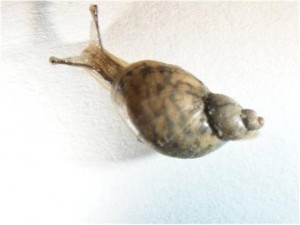
Cone Shaped or Cone Shell Snail Photo Credits: Heather M. Young, Biological Scientist, NFREC-Quincy
Occasionally on shipments of container plants, snails (terrestrial air-breathing gastropods) may be found attached to the container pot. Snails are abundant in nearly all parts of the world except the arctic regions, and feed almost entirely on vegetation. Those mostly encountered on nursery container plants are cone shaped reaching 1/2 to 2 1/2 inches in length and having an external enclosing spiral shell or occasionally rounded shell with four to five rapidly expanding whorls that are 1 to 1 1/4 inches in size.
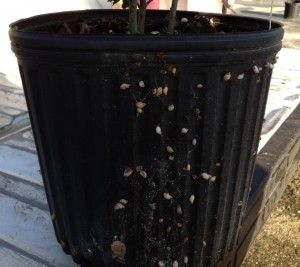
Image Credit: Henry Grant, Gadsden County Extension.
There are many species of snails. Most snails found on shipments are those restricted to tropical and semitropical regions requiring high humidity and warm temperatures. The U.S. has four native genera of Bulimulidae: Rhabdotus, Drymaeus, Orthalicus and Liguus. Of these, the last three genera are native to Florida. There is also another introduced genus in Florida, Bulimulus, which is primarily terrestrial. Other introduced species are Zachrysia provisoria and Caracolus marginellus in the Family Camaenidae occurs in Florida and found throughout much of the tropics.
Snails are also found in moist, shaded locations, which are similar to conditions found in container plant production areas, weedy locations or in organic trash. Most lay eggs throughout the season. Overwintering eggs may hatch in spring.
The following are general snail management suggestions:
- Remove excess organic material under plants. Organic materials provide moist hiding places for eggs and smaller snails, and sometimes as food sources.
- Monitor plant and environment moisture to reduce favorable snail habitats.
- When possible, remove the snails by hand, which is a reasonable, effective, nontoxic and environmentally acceptable control option.
- Check with your favorite garden store outlet for bait, biological, or chemical product control options.
For more information check out this gardening in a minute segment on snails and slugs.
by Larry Williams | Sep 16, 2013
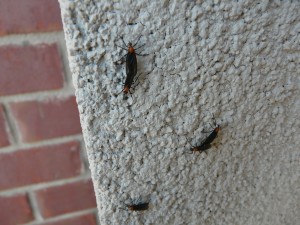
Adult lovebugs on building, Photo Credit: Larry Williams
Contrary to popular belief, lovebugs were not introduced to the state by the University of Florida. This insect is an invasive species from Central America. Lovebugs migrated from Central America, traveling through Texas and Louisiana to get to Florida. They were first reported in Florida during the late 1940s. They are now found throughout the state. Prevailing winds, vehicle traffic, sod transport, increased habitat along highways and expansion of pastures may have assisted the movement of lovebugs throughout Florida. UF researchers had nothing to do with it.
Even though it’s an interesting story, University of Florida researchers did not genetically engineer lovebugs to kill mosquitoes. A complete understanding of this insect will prove that this could not have possibly been the case. First, lovebugs do not feed on insects. They feed on pollen and nectar found in flowers. Secondly, they lack mandibles (jaws) and grasping legs to hold onto and eat mosquitoes. Thirdly, they are slow flying insects that lack speed to go after mosquitoes. Additionally, lovebugs are active during the day (usually between 10 a.m. and 4 p.m., in temperatures above 84°F). Most mosquitoes are out during the evening and night. Finally, lovebugs are only adults for a few weeks each year. The lovebug is a poor candidate to genetically engineer as a mosquito predator, even if it were possible.
Female lovebugs are attracted to UV irradiated aldehydes, a major component of automobile exhaust fumes. They may confuse these chemicals with odors emitted from decaying organic matter where the female deposits her eggs. Heat also has been shown to attract lovebugs and may be another reason for their abundance along highways.
Lovebug larvae feed on decaying plant material, assisting with converting plant debris into organic components that can again be used by the growing plants.
Adult lovebugs are active during late April and May and again August and September. Each flight lasts for a four to five week period.
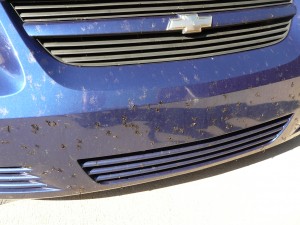
Lovebugs splattered on car, Photo Credit: Larry Williams
Even though lovebugs can be a problem as they splatter on our automobiles, be thankful that they don’t bite, sting or hang around all year.
by Matthew Orwat | Sep 16, 2013

Azaleas pruned late in the fall will have little or no bloom in the spring. Image Credit: Matthew Orwat
Although Northwest Florida is well known for its beautiful Azalea displays every spring, many do not understand that these shows of bloom could be sacrificed completely by pruning at the wrong time.
Pruning Azaleas in the fall will result in a loss of spring bloom the following year because most bloom on previous years’ wood. This means that they flower on growth put on throughout the previous growing season. If a gardener removes the previous season’s new growth, they are removing the blooms as well.
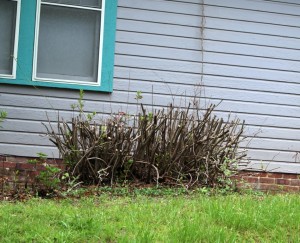
Fall Pruned Azalea. Image Credit Matthew Orwat
So, when is the proper time to prune Azaleas? The ideal time to prune is directly after the spring bloom. This will give the plant enough time to generate abundant new growth, thus maximizing bloom next spring.
For more information on pruning Azaleas or on general Azalea culture, please read the UF / IFAS publication Azaleas at a Glance or check out the Pruning Azalea page on Gardening in a Minute.
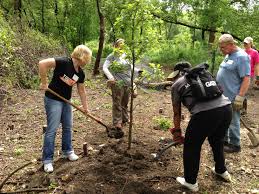
by | Sep 16, 2013
While the recently passed Labor Day is often is touted as the traditional “end of summer,” according to the calendar, fall officially will begin with the fall equinox on Sept. 22nd at 4:44 EDT. In north Florida, however, we know good and well that our summer season extends a good bit longer.
Still, even if it just feels right, there is something going on now. When you walk out in the morning, the air feels just a bit more comfortable. The days are getting shorter, and that is beginning to have an effect. Perhaps it’s just wishful thinking, but if you squint just right, you can ALMOST see the end of our long and brutally hot summer.
The word “fall” commonly conjures up images of harvest, falling leaves, the end of the growing season and the beginning of dormancy leading into winter. For gardeners in North Florida, however, the traditional fall period is not a time of winding things down in the garden or even landscape but of revival and renewed effort. It’s a time when we finally can get back into outside and enjoy ourselves as the debilitating heat of summer starts to lose its grip on the weather.
For the next couple of months we will experience a gradual shift to milder weather. There will be cool spells followed by decidedly hot, summer-like weather, but as we move into late October, cooler weather will begin to dominate the scene. Not until mid-to late November do we generally experience the nippy cold weather and changing leaves that tell us, yes, indeed, fall has finally arrived.
One thing you that you might notice that may surprise you may be an increase of vigor in your warm-season bedding plants in September. Even heat-tolerant flowers do not always look their best in August.
Since shorter days mean fewer hours of intense heat, even though the daytime highs may stay about the same, plants begin to experience less stress. This encourages a “second wind”, if you will, in the flower garden that may last well into October or early November. Given this, consider cutting back some of your summer bedding plants and flowers that have grown tall and leggy over the just passed long growing season. This should be done in by the second or third week in September at the latest – and generally involves cutting plants back about one-third to one-half their height.
While you’re at it, it might be a good idea to impose some order on those overgrown flower beds. In addition to cutting back, groom plantings to remove dead flowers and unattractive foliage.
If plants are leaning or have fallen over onto nearby neighbors, prop them up or stake them so they will stand upright. Just about every year at this time I find the remains of some unfortunate plant that was overwhelmed when larger, more vigorous, nearby plants leaned over it.
In addition, if you haven’t done so already, gently trim your everblooming rose bushes, including such popular groups as Hybrid Teas, Grandifloras, Floribundas, Miniatures, Teas, Polyanthas, Bourbons, Chinas and English roses, to name just a few. This should be a very light trimming, little more than deadheading, since the main pruning of everblooming types is done in mid February. On the other hand, keep in mind that many old-fashioned climbers, ramblers, Lady Banks roses and some bush roses that bloom heavily only in spring to early summer will bloom next year on the growth they made this summer. Those roses should not be cut back at all now.
Even though you can get back into the garden to work, it is still too early to plant hardy trees, shrubs, ground covers and vines in the landscape. Temperatures in the 80s and 90s likely will be common in September, and that is still too stressful for new plantings. Wait at least until the cooler weather of October, since the ideal planting season for hardy trees, shrubs and ground covers really is from November through February. And for those that like to plant pecan trees, these are often done in bare root when the trunk of the tree is about the size of a pencil. These MUST be done when completely dormant or you will not have a successful outcome.

While Fall is for Planting, be sure that you don’t start too early!
Keep in mind that even though they will begin to show up in area nurseries this month, it is also is too early to plant cool-season bedding plants. Even if you have an area where your summer flowers have finished and have been removed, it is still too hot to plant most cool-season bedding plants. Instead mulch the area now and wait until the reliably cooler weather of October or November before you plant your bedding plants.
Spring-flowering bulbs, such as tulips and daffodils, become available this month, but there is absolutely no hurry to plant them. Purchase them if you like while the selection is good, but wait to plant your spring flowering bulbs from mid-October through early December.
Keep in mind that insects and diseases stay active through the fall, so continue to control any pest problems with timely applications of the proper material. In addition, don’t forget, now as always, water well during dry periods, and you should have an excellent crop of flowers in October through November.
I guess if you think about it, it’s best to say that Labor Day really marks that time in north Florida when we can anticipate the soon-to-arrive milder weather and look forward to enjoying the delights of gardening over the next few months. When the fall equinox arrives later this month, don’t get carried away. For us, summer will still be lingering for a little while longer.
by Matthew Orwat | Sep 15, 2013
Does Your Garden Irrigation Inflate Your Water Bill?
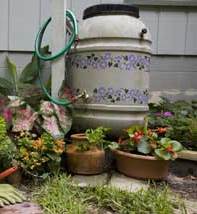
Image Credit: UF / IFAS
Flush High Irrigation Bills Down The Drain !
- Build A Rain Barrel
- Find Out How at our Workshop
- Saturday October 12th 2013 9am-12pm
- Location: Washington County Ag Center 1424 Jackson Ave
- UF / IFAS Washington County Extension 1424 Jackson Ave. Chipley, FL. East Wing Conference Room
You will engage in hands on construction of a rain barrel to take home and use to water your garden. All supplies will be furnished by the UF / IFAS Washington County Extension Master Gardeners at a cost of only $40.00 per person / barrel ! $10.00 to audit without barrel.
Call Matt or Cynthia at the Washington County Extension Office to
register at 850-638-6180 or email Matt at mjorwat@ufl.edu
or email Matt at mjorwat@ufl.edu
Master Gardner Advanced Training CEU’s offered with approval of your County Extension Agent
2013 Fall Rainbarrel Workshop Flyer








